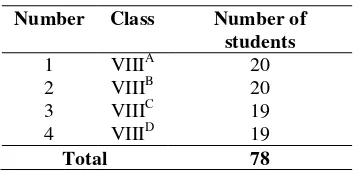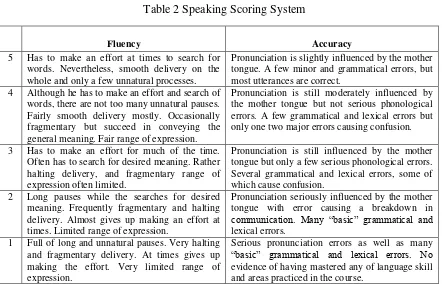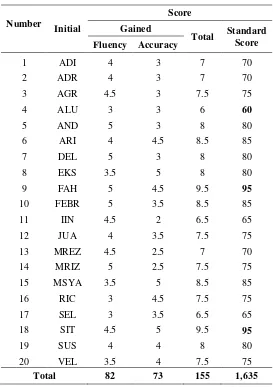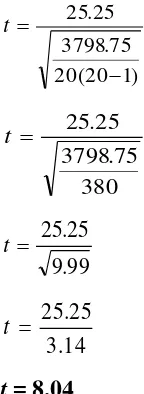e-Journal of English Language Teaching Society (ELTS) Vol. 3 No. 1 2015 – ISSN 2331-1841 Page 1
DEVELOPING SPEAKING SKILL
OF GRADE VIII STUDENTS
THROUGH SHORT CONVERSATION
Resha P. W1, Mawardin M.Said2, Abdul Waris3
Abstract
The purpose of this research was to find out whether or not the grade VIII students’ speaking skill at SMP Negeri 19 Palu can be developed by applying short conversation. This research employed pre-experimental design. The sample of this research was the grade VIII students at SMP Negeri 19 Palu consisting of 20 students and selected by using cluster sampling technique. The instrument of data collection was a test; pre-test and post-test. The pre-test was used to measure the students’ speaking skill before treatment; and the post-test was used to measure the students’ speaking skill after the treatment was given. The data was analyzed statistically. The result of data analysis showed that the hypothesis was accepted by regarding to the analysis that t-counted (8.04) is higher than the t-table (1.729). The degree of freedom (df) of the table is 20-1 = 19. The level of significance is set up at 0.05. It means that the application of short conversation can significantly develop the grade VIII students’ speaking skill at SMP Negeri 19 palu.
Keywords: Developing, Speaking Skill, Short Conversation
INTRODUCTION
Speaking is one of the skills in language learning that has to be fulfilled. Speaking is a
skill which holds oral communication that involves meaning derivation between two persons
or more, as the speaker and the listener. Both are talking about the content that is related to
their needs, situation, and purposes. The spoken contents or ideas contain information that we
are expected to hold in memory, and all at once to give feedback to the interlocutor.
According to Chaney and Burke (1998:13)
Speaking is the process of building and sharing meaning through the use of verbal and non-verbal symbols, in a variety of the context. The skill is acquired by much repetition; it is primarily a neuromuscular and not an intellectual process. It consists of competence in sending and receiving messages.
Relates to the definition above, it can be inferred that speaking is expressing ideas,
opinions, or feelings to others by using words or sounds.
1
Prodi Pendidikan Bahasa Inggris FKIP Universitas Tadulako - email: [email protected]
2
email: [email protected]
3
e-Journal of English Language Teaching Society (ELTS) Vol. 3 No. 1 2015 – ISSN 2331-1841 Page 2
There are some components in speaking. The students who master the components of
speaking can easily perform their speaking. According to Heaton (1988:100), “There are
three components of speaking. They are accuracy, fluency, and comprehensibility”. The used
of those components of speaking can affect the listener to comprehend, to be clear, and to be
easy to understand messages produced by the speaker. As the affect, the process of
communication will be run well.
Fluency relates to the condition or quality of being fluent. It is one of the learners’ problems in using English orally. Speaker should transfer his/her thoughts fluently where the
speaker shall not too slow and not too fast or other listeners may get bored or lose their
attention. Gu (2010:6) states “Fluency is the ability to read, speak, or write easily, smoothly, and expressively”. At the same time, Davis (1989:25) defines “Fluency in speaking is achieved through the series to the situational dialogue”. It can be concluded that in fluency, the speaker tries to use the language in simple form by focusing on the point of messages
conveyed. They may use sufficient grammar in order to get easier to comprehend the
meaning. The speaker does not have a long pause in searching for perfect grammar in
speaking.
One of the goals of learners in learning speaking is accuracy. It is related to the exact
of being correct and without error, especially the result from careful effort. In this case, good
pronunciation and structure can make the speakers’ utterances clearly understandable.
Students at the school faced this problem when they pronounce English words. It is caused by
their mother tongue. They should be accustomed to practicing those sounds by giving lot of practice. Gu (2010:7) exposes “Accuracy is the ability to produce the correct sentences using correct grammar and vocabulary”. In this case the speakers are demanded to use correct
grammar in using the target language.
The most important factor in communication is comprehensibility. Comprehensibility
is the ability of how to make the language produced is understandable for the interlocutor.
Therefore, those speakers who can make their interlocutors understand can be justified by
having a good comprehensibility. According to Richard and Rodgers (1986:5), “The comprehensibility includes the ability to understand someone’s utterance (speaker) and ability in speaking to be understood by other (listener)”. It shows that the content of the speaking should be well understood by both the speaker and the listener before they took a
communication.
The grade VIII students of SMP Negeri 19 Palu got difficulties when they speak
e-Journal of English Language Teaching Society (ELTS) Vol. 3 No. 1 2015 – ISSN 2331-1841 Page 3
not interested and motivated in learning English, they had lack of vocabulary, they were not
confident to speak English directly with their English teacher and their classmates, they were
afraid of making mistakes in speaking English, and they rarely practiced speaking English. It
means that they need more chance to practice it. To make the research specific, the researcher
provided the limitation of the research. The researcher focused on her research in developing students’ speaking skill through short conversation focusing on fluency and accuracy.
Short conversation is one of activity to help beginning learners build basic English
skill. It consists of six up to twelve sentences between two people. This activity gives more
opportunity to the student to speak. It is also called as a free communicative interaction. It
means that the students are free to use their own words to talk about their own way.
According to Thornbury (1984:25) “Conversation models can help students increase their
fluency, accuracy, and confidence by encouraging them to progress from giving brief response to engaging in more expanded, interactive discussion”. The teacher can start or create the situation in which students or learners want to talk. Conversation involves at least
two people where both speaker and listener need to communicate to exchange information,
ideas, opinions, views, or feelings. The advantage of short conversation is that the learners
are not only able to understand the words of English but also able to understand the correct
English rules. It can be said that learning short conversation can represent the learners’
intention by using suitable words in the sentence.
Based on the explanation above, the researcher formulated a research question as follow:
Can grade VIII students speaking skill at SMP Negeri 19 Palu be developed through Short
Conversation?. The objective of the research was to find out that the students’ speaking skill
of grade VIII students of SMP Negeri 19 Palu could be developed through Short
Conversation.
METHODOLOGY
In conducting this research, the researcher applied pre-experimental research design.
It means that there was only one class as the sample of the research. The pre-test was given to measure the student’s speaking ability before the treatment. Then, the researcher treated the students through short conversation, and the post-test was given to measure the effect of this
technique. The design of this research is proposed by Arikunto (2006: 85).
01 X 02
e-Journal of English Language Teaching Society (ELTS) Vol. 3 No. 1 2015 – ISSN 2331-1841 Page 4
01 : pre-test X : treatment 02 : post-test
Population is a group of people, things, or events which are going to be investigated.
Best (1981:8) states, “Population is any group of individuals that have one or more characters in common had are of interest to the researcher”. The population of this research is the grade VIII student at SMP Negeri 19 Palu. It consists of four parallel classes. The total number of
population is 78 students.
Table 1 Population
Number Class Number of
students 1 VIIIA 20 2 VIIIB 20 3 VIIIC 19 4 VIIID 19
Total 78
Best (1981:8) argues, “Sample is a small proportion selected for observation and analysis.” In selecting the sample, the researcher applied cluster sampling technique. The researcher chose VIIIB as the sample of the research which consisted of 20 students.
Ary et al (2002: 35) adds, “Independent variables are antecedent to dependent
variable and are known or are hypothesized to influence the dependent variable, which is the
outcome. The treatment is the independent variable and the outcome is dependent variable.”
In this research, there were two variables which were categorized into dependent and
independent variables. The researcher formulated speaking skill as the dependent variable
and the application of short conversation as the independent variable of this research.
In conducting this research the researcher used two different kinds of instruments;
they are test and non test instruments. The test instrument was in form of oral test consisting
of pre-test and post-test. On the other side, the non test covered observation. The non-test
instrument is used to collect additional information related to the research before the
researcher conducted the treatment. In administering the test to the students, the researcher
employed the scale of scoring as proposed by Heaton (1988:100) as in table 2.
The researcher analyzed the data by using statistical analysis. It is used to analyze the
test instruments result (pre-test and post-test). The researcher computed the individual score
by using formula recommended by Arikunto (2006:308):
1 0 0 X
N X
e-Journal of English Language Teaching Society (ELTS) Vol. 3 No. 1 2015 – ISSN 2331-1841 Page 5
Where:
∑ : standard score
X : raw score
N : maximum score
Table 2 Speaking Scoring System
Fluency Accuracy
5 Has to make an effort at times to search for words. Nevertheless, smooth delivery on the whole and only a few unnatural processes.
Pronunciation is slightly influenced by the mother tongue. A few minor and grammatical errors, but most utterances are correct.
4 Although he has to make an effort and search of words, there are not too many unnatural pauses. Fairly smooth delivery mostly. Occasionally fragmentary but succeed in conveying the general meaning. Fair range of expression.
Pronunciation is still moderately influenced by the mother tongue but not serious phonological errors. A few grammatical and lexical errors but only one two major errors causing confusion.
3 Has to make an effort for much of the time. Often has to search for desired meaning. Rather halting delivery, and fragmentary range of expression often limited.
Pronunciation is still influenced by the mother tongue but only a few serious phonological errors. Several grammatical and lexical errors, some of which cause confusion.
2 Long pauses while the searches for desired meaning. Frequently fragmentary and halting delivery. Almost gives up making an effort at times. Limited range of expression.
Pronunciation seriously influenced by the mother tongue with error causing a breakdown in communication. Many “basic” grammatical and lexical errors.
1 Full of long and unnatural pauses. Very halting and fragmentary delivery. At times gives up making the effort. Very limited range of expression.
Serious pronunciation errors as well as many “basic” grammatical and lexical errors. No evidence of having mastered any of language skill and areas practiced in the course.
The researcher computed the students’ mean score by using formula as recommended by Arikunto (2006:306):
mean deviation score using the following formula from Arikunto (2006:307):
� = �
Where:
Md : mean deviation
e-Journal of English Language Teaching Society (ELTS) Vol. 3 No. 1 2015 – ISSN 2331-1841 Page 6
N : number of students
After that, the researcher also calculated the square deviation by using the formula
proposed by Arikunto (2006:308) as follow:
�2� = �2− � ²
Where:
�2� : the sum of square deviation
�2 : the number of deviation (�2)
� : the sum of deviation
N : number of students
In proving the significance between the mean of pre-test and post-test, the researcher
applied formula proposed by Bungin (2005:191) as follow:
1
2
N N
d M d t
Where:
T : t-test score Md : mean deviation
�2 : the number of deviation (d2
) N : number of students
FINDINGS
The researcher presents and analyzes the data taken from oral test (pre-test and
post-test). The researcher used descriptive and statistical analysis. The data from the observation
are explained descriptively while the test is explained statistically. In order to conclude whether the students’ speaking skill was developed or not, the researcher tested the students both before and after treatment. The pre-test was conducted on September 8, 2014 and the
post-test was held on October 11, 2014. Result of the pre-test and post-test are presented in
table 3 below.
Based on the table 3, the highest score of the pre-test was 70 and the lowest is 20. After getting the total score of the students, the researcher computed the students’ mean score by using the formula below:
e-Journal of English Language Teaching Society (ELTS) Vol. 3 No. 1 2015 – ISSN 2331-1841 Page 7
Table 3 Result of the Pre-test
Number Initial
After the researcher conducted the treatment, the students’ post-test results are shown as in table 4.
After doing the computation, the researcher found that the highest score is 90 and the
e-Journal of English Language Teaching Society (ELTS) Vol. 3 No. 1 2015 – ISSN 2331-1841 Page 8
Table 4 Result of the Post-test
Number
Initial
Score
Gained
Total Standard
Score Fluency Accuracy
1 ADI 4 3 7 70
2 ADR 4 3 7 70
3 AGR 4.5 3 7.5 75
4 ALU 3 3 6 60
5 AND 5 3 8 80
6 ARI 4 4.5 8.5 85
7 DEL 5 3 8 80
8 EKS 3.5 5 8 80
9 FAH 5 4.5 9.5 95
10 FEBR 5 3.5 8.5 85
11 IIN 4.5 2 6.5 65
12 JUA 4 3.5 7.5 75
13 MREZ 4.5 2.5 7 70
14 MRIZ 5 2.5 7.5 75
15 MSYA 3.5 5 8.5 85
16 RIC 3 4.5 7.5 75
17 SEL 3 3.5 6.5 65
18 SIT 4.5 5 9.5 95
19 SUS 4 4 8 80
20 VEL 3.5 4 7.5 75
Total 82 73 155 1,635
From the calculation above, it shows that there were different results in speaking skill between the students’ mean score in the pre-test and the post-test. The students’ mean score in the post-test (77.85) is greater than students’ mean score in the pre-test (47.25). Those show that students’ achievement greatly developed after the treatment.
Based on the table 5, the researcher computed the mean deviation as follows:
N d Md
20 505
Md
Md = 25.25
Table 5 Score and Square Deviation
Number Initial Score
e-Journal of English Language Teaching Society (ELTS) Vol. 3 No. 1 2015 – ISSN 2331-1841 Page 9
deviation of pre-test and post-test as shown below:
N
significant difference between pre-test and post-test. The researcher used the statistical
analysis as the following formula:
e-Journal of English Language Teaching Society (ELTS) Vol. 3 No. 1 2015 – ISSN 2331-1841 Page 10
degree of freedom (df) 20 (N-1=20-1=19), t-counted (8.04) is greater than t-table (1.729). It
could be concluded that the research hypothesis is accepted. In other words, short
conversation is effective to develop speaking skill of grade VIII students at SMP Negeri 19
Palu.
DISCUSSION
In doing the research, the researcher focused on two components of speaking. They
were fluency and accuracy. Then, the researcher needs to test the students’ speaking skill
whether they can pass the standard score (70) or not. In giving the pre-test related to the two
components of speaking, the researcher presented the result of pre-test in the following table.
Table 6 The Students’ Error Percentage in Pre-test
Pre-test Students percentage of the students’ error which is 70%, while it is 90% of the students who got error in accuracy as can be seen from the table that 18 students who could not pass the test. By
looking at the percentage of the students’ error, the researcher took a conclusion that the
students of SMP Negeri 19 Palu have problems in speaking especially in fluency and
accuracy. Furthermore, it is that accuracy is the difficult one for the students to pass instead
e-Journal of English Language Teaching Society (ELTS) Vol. 3 No. 1 2015 – ISSN 2331-1841 Page 11
After getting the students’ scores in the pre-test, the researcher gave the treatment to
the students in eight meetings by applying short conversation in developing their speaking
skill. In the first treatment, the researcher explained the material to the students, and then
divided them into several groups. Each group consists of two students only. After explaining
the material to the students, the researcher asked them to make a short conversation based on
the material given. Before going to the main activity, the researcher ensured whether each
group had clearly known the context given or not. The researcher gave a time to each group
not only to make a short conversation but also to discuss about the context offered by the
researcher. After that, the researcher allowed each group to present their short conversation to
other groups. For each meeting, the researcher gave the students different materials to make
and to practice in front of the class. It is aimed to develop their speaking skill through short
conversation. Having given the treatment, the researcher finally administered the post-test to
the students in order to measure their progress. The result of post-test is presented in the
following table.
Table 7 The Students’ Error Percentage in Post-test
Post-test Students
error
Students’ Error in Percentage
Standard Score
Fluency 3 15 70
Accuracy 9 45 70
The result of post-test above shows that there is a significant difference between the
result in the pre-test and in the post-test. Afterthe researcher administered the treatment, the
students felt easier to pronunce and to make a short conversation in correct grammar. It can
be seen from the number of students who can reach the standard score. It was also supported
by the result of the percentage in students’ error in the post-test especially in fluency; there
are only 15% students who got error, while in accuracy, the percentage shows that only 45%
students who got error in accuracy. The result indicates that there is a different improvement
between the result of the pre-test and post-test. After comparing the result in the pre-test and
post-test, the researcher concludes that there is a significant progress in developing students’
speaking skill by applying short conversation. It means that short conversation can be used in developing students’ speaking skill. This fact makes the researcher comess into a conclusion that there is a significant progress after the researcher applied short conversation in teaching
e-Journal of English Language Teaching Society (ELTS) Vol. 3 No. 1 2015 – ISSN 2331-1841 Page 12
The research about short conversation by focusing on fluency and accuracy in developing students’ speaking skill had been conducted by some researchers previously. Dewi (2010) becomes one of the researchers who conducted a research by applying
pre-experimental research design; she found out that the students’ result in speaking skill based
on fluency and accuracy was increased by applying group conversation to the students.
Furthermore, this current research was also an experimental research. The researcher concerned to find out the students’ achievement in learning speaking skill focusing on fluency and accuracy. She apllied short conversation as a media in teaching speaking skill. As
the result, the researcher found that there is a significant difference between the pre-test and
the post-test. Therefore, the researcher concludes that short conversation can be considered as
one of the effective ways in teaching and learning speaking.
CONCLUSION AND SUGGESTIONS
Based on the data of this research, it can be concluded that grade VIII students
speaking skill at SMP Negeri 19 Palu can develop through short conversation. It could be
seen from the mean score of the pre-test (47.25) and the post-test (77.85). It indicates that the
speaking skill of grade VIII students at SMP Negeri 19 palu developed.
Dealing with the conclusion above, the researcher would like to provide some
suggestions. The researcher expects that the suggestion can be available for teachers and
students. The teachers should not force the students to make their speech but they should be
able to make students interested in learning English especially in speaking by applying short
conversation. The teachers may apply short conversation because it can develop students’
speaking skill. It encourages the students to enjoy and to motivate in learning speaking. As a
teacher, English teachers should select and prepare appropriate media or techniques to
develop the students’ ability, motivation, and interest in learning vocabulary to develope his/her students in speaking skill. Besides, they need to create good atmosphere in the
classroom so that the teaching learning process becomes interesting, easy, and enjoyable. For
the students, they should study hard and increase their motivations in developing their skills
in speaking. Also, they should practice their speaking as much as possible whether in class or
out of classroom.
REFERENCES
e-Journal of English Language Teaching Society (ELTS) Vol. 3 No. 1 2015 – ISSN 2331-1841 Page 13 Ary, D., Jacobs, L., & Razavieh, A. (2002). Introduction to Research in Education. (Sixth
Edition). California: Wadsworth, Thomson Learning.
Best, J. W. (1981). Research in Education. New Jersey: Prentice Hall Englewood Clieffs.
Bungin, B. (2005). Metodologi Penelitian Kuantitatif. Jakarta: Prenada Persada.
Chaney, A.L. and Burke T.L. (1998). Teaching Oral Communication in Grades K-8. Boston: Allyn and Bacon.
Davis, E.C. (1989). An Integrated Skill Approach Developing Listening Profiency and Improving Speaking Ability. Cambridge: Corporative Program.
Dewi. R. K. (2010). Improving Students’ Speaking Skill through Dialogue. Surakarta: Sebelas Maret University
Gu, P. (2010). Accuracy Vs Fluency. http//www.icalweb.com/wiki, Retrieved on the 30th oct 2013.17.15 pm.
Heaton, G, B. (1988). Writing English Langauge Tests. Harlow: Longman group limited.
Richards, J. C. and Rodgers, T. S. (1986). Approaches and Methods in Language Teaching. Cambridge: Cambridge University Press.




